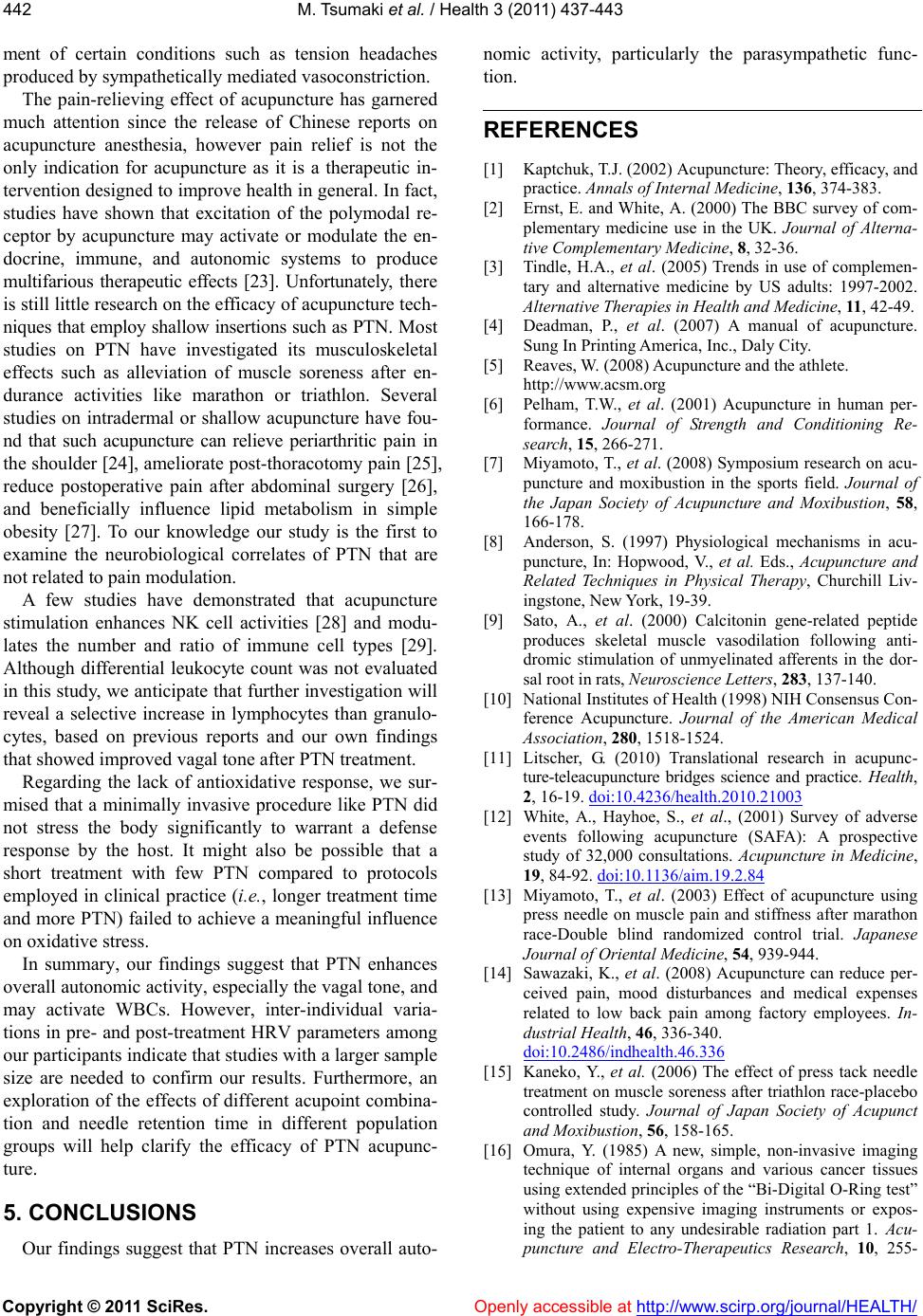
M. Tsumaki et al. / Health 3 (2011) 437-4 43
Copyright © 2011 SciRes. Openly accessible at http://www.scirp.org/journal/HEALTH/
442
ment of certain conditions such as tension headaches
produced by sympathetically mediated vasoconstriction.
The pain-relieving effect of acupuncture has garnered
much attention since the release of Chinese reports on
acupuncture anesthesia, however pain relief is not the
only indication for acupuncture as it is a therapeutic in-
tervention designed to improve health in general. In fact,
studies have shown that excitation of the polymodal re-
ceptor by acupuncture may activate or modulate the en-
docrine, immune, and autonomic systems to produce
multifarious therapeutic effects [23]. Unfortunately, there
is still little research on the efficacy of acupuncture tech-
niques that employ shallow insertions such as PTN. Most
studies on PTN have investigated its musculoskeletal
effects such as alleviation of muscle soreness after en-
durance activities like marathon or triathlon. Several
studies on intradermal or shallow acupuncture have fou-
nd that such acupuncture can relieve periarthritic pain in
the shoulder [24], ameliorate post-thoracotomy pain [25],
reduce postoperative pain after abdominal surgery [26],
and beneficially influence lipid metabolism in simple
obesity [27]. To our knowledge our study is the first to
examine the neurobiological correlates of PTN that are
not related to pain modulation.
A few studies have demonstrated that acupuncture
stimulation enhances NK cell activities [28] and modu-
lates the number and ratio of immune cell types [29].
Although differential leukocyte count was not evaluated
in this study, we anticipate that further investigation will
reveal a selective increase in lymphocytes than granulo-
cytes, based on previous reports and our own findings
that showed improved vagal tone after PTN treatment.
Regarding the lack of antioxidative response, we sur-
mised that a minimally invasive procedure like PTN did
not stress the body significantly to warrant a defense
response by the host. It might also be possible that a
short treatment with few PTN compared to protocols
employed in clinical practice (i.e., longer treatment time
and more PTN) failed to achieve a meaningful influence
on oxidative stress.
In summary, our findings suggest that PTN enhances
overall autonomic activity, especially the vagal tone, and
may activate WBCs. However, inter-individual varia-
tions in pre- and post-treatment HRV parameters among
our participants indicate that studies with a larger sample
size are needed to confirm our results. Furthermore, an
exploration of the effects of different acupoint combina-
tion and needle retention time in different population
groups will help clarify the efficacy of PTN acupunc-
ture.
5. CONCLUSIONS
Our findings suggest that PTN increases overall auto-
nomic activity, particularly the parasympathetic func-
tion.
REFERENCES
[1] Kaptchuk, T.J. (2002) Acupuncture: Theory, efficacy, and
practice. Annals of Internal Medicine, 136, 374-383.
[2] Ernst, E. and White, A. (2000) The BBC survey of com-
plementary medicine use in the UK. Journal of Alterna-
tive Complementary Medicine, 8, 32-36.
[3] Tindle, H.A., et al. (2005) Trends in use of complemen-
tary and alternative medicine by US adults: 1997-2002.
Alternative Therapi es in Health and Medicine, 11, 42-49.
[4] Deadman, P., et al. (2007) A manual of acupuncture.
Sung In Printing America, Inc., Daly City.
[5] Reaves, W. (2008) Acupuncture and the athlete.
http://www.acsm.org
[6] Pelham, T.W., et al. (2001) Acupuncture in human per-
formance. Journal of Strength and Conditioning Re-
search, 15, 266-271.
[7] Miyamoto, T., et al. (2008) Symposium research on acu-
puncture and moxibustion in the sports field. Journal of
the Japan Society of Acupuncture and Moxibustion, 58,
166-178.
[8] Anderson, S. (1997) Physiological mechanisms in acu-
puncture, In: Hopwood, V., et al. Eds., Acupuncture and
Related Techniques in Physical Therapy, Churchill Liv-
ingstone, New York, 19-39.
[9] Sato, A., et al. (2000) Calcitonin gene-related peptide
produces skeletal muscle vasodilation following anti-
dromic stimulation of unmyelinated afferents in the dor-
sal root in rats, Neuroscience Letters, 283, 137-140.
[10] National Institutes of Health (1998) NIH Consensus Con-
ference Acupuncture. Journal of the American Medical
Association, 280, 1518-1524.
[11] Litscher, G. (2010) Translational research in acupunc-
ture-teleacupuncture bridges science and practice. Health,
2, 16-19. doi:10.4236/health.2010.21003
[12] White, A., Hayhoe, S., et al., (2001) Survey of adverse
events following acupuncture (SAFA): A prospective
study of 32,000 consultations. Acupuncture in Medicine,
19, 84-92. doi:10.1136/aim.19.2.84
[13] Miyamoto, T., et al. (2003) Effect of acupuncture using
press needle on muscle pain and stiffness after marathon
race-Double blind randomized control trial. Japanese
Journal of Oriental Medicine, 54, 939-944.
[14] Sawazaki, K., et al. (2008) Acupuncture can reduce per-
ceived pain, mood disturbances and medical expenses
related to low back pain among factory employees. In-
dustrial Health, 46, 336-340.
doi:10.2486/indhealth.46.336
[15] Kaneko, Y., et al. (2006) The effect of press tack needle
treatment on muscle soreness after triathlon race-placebo
controlled study. Journal of Japan Society of Acupunct
and Moxibustion, 56, 158-165.
[16] Omura, Y. (1985) A new, simple, non-invasive imaging
technique of internal organs and various cancer tissues
using extended principles of the “Bi-Digital O-Ring test”
without using expensive imaging instruments or expos-
ing the patient to any undesirable radiation part 1. Acu-
puncture and Electro-Therapeutics Research, 10, 255-